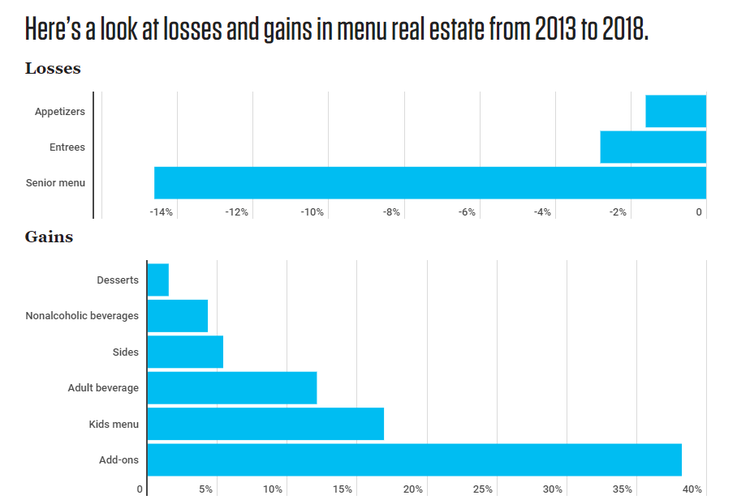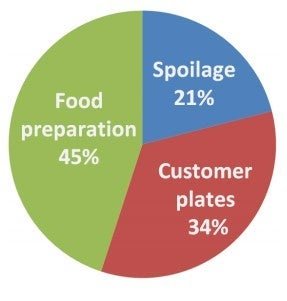How a Smaller Menu Can Lead to Larger Profits
As the COVID-19 pandemic hit the U.S., major restaurant brands responded by streamlining their menu size. Denny's, IHOP, Dave & Buster's, McDonald's, and Red Robin cut dozens of items as part of ongoing efforts to increase efficiency and boost profits.
Although some restaurants intend to expand their menu in the future, others say their limited menus are here to stay. Learn how a smaller menu can lead to larger profits and improved customer experiences.
Benefits of a smaller menu
Smaller menus are often easier for small businesses to manage. However, due to COVID-19, big chains decreased menu offerings to satisfy investors and remain profitable. On a 2020 first-quarter earnings call, Paul Murphy III, president and CEO of Red Robin, said:
"Our execution has also been enhanced by a simplified menu with one-third fewer items yielding little to no negative guest feedback. Reducing our menu by 55 items has facilitated improved back of the house speed and efficiency as restaurants have adjusted to reduce staffing levels and has improved food quality with consistency. Given this success, we plan to leverage a simplified menu as part of our ongoing business plan."
IHOP explained its reasoning behind switching from a 12-page menu to a two-page menu in an email to TODAY. Brad Haley, IHOP's chief marketing officer, said the company made the move to "simplify operations for new and returning team members and to help ensure that we can maintain a stable supply chain for all of the ingredients we use."
The benefits of a smaller menu include:
- Easier to train new employees
- Faster cook times
- Higher-quality meals
- Reduced waste
- Less inventory to manage
- Decreased restaurant costs
How big should a restaurant menu be?
Although there's no set answer for the size of a restaurant menu, many experts recommend using the rule of seven, meaning seven items or less per menu category. However, the average number of items on a restaurant menu is as diverse as the wide variety of restaurant concepts.
A Technomic white paper shows that, in the first quarter of 2015, "the average number of menu items at a Top 500 chain reached a peak of 137.7. But by Q4 of that same year, menus hit a two-year low of 130.4 items." Since then, this number has hovered around 132 menu items.
Yet, 2020 was a unique year, resulting in some restaurants cutting their menus in half. To put it simply, your menu size depends on your staffing levels and should consider trends in the restaurant industry while also balancing guest needs.

Certain menu categories shrank between 2013 and 2018, with senior meals taking the biggest hit and add-on options increasing by nearly 40%. Image source: Author
6 ways a smaller menu increases profits
If you want to improve your restaurant's profit margins, you should decrease expenses while boosting income. Your menu plays a role in both.
Restaurateurs use menu engineering techniques to determine pricing and item placement. But you can also adjust your menu mix to reflect seasonal changes or economic concerns. Explore the following ways to increase restaurant profits by taking advantage of the benefits of a smaller menu.
1. Reduces labor costs
Extensive menus may require large kitchen teams capable of producing various dishes quickly. Each menu item you add increases ingredient prep time, cleanup, and time spent on meal preparation.
Removing items from your menu helps you shorten ticket times and, in some cases, run shifts with fewer employees. For instance, with the right kitchen setup, one or two people can handle the grills and fryers, while a third person adds cold or warm sides before sending orders out to the table.
2. Allows for quicker employee training
Memorizing a menu with 132 items isn't easy. Although your staff quickly learns the specifics of popular items, they're often caught off-guard with guest questions about dishes infrequently ordered.
By eliminating some dishes from your menu, you can save time on training and improve staff members’ knowledge of meals. Moreover, a smaller menu makes it easier for new hires to sample and form an opinion on each dish, thereby enhancing their sales techniques and ability to recommend meals based on personal experience.
3. Streamlines inventory management and cost
Tracking stock-keeping units (SKUs) gets trickier as you increase menu items and ingredients. In some cases, you can add menu items using existing ingredients, but you usually need to buy new products, track inventory usage, and find a place for proper storage.
By shortening your menu, you have fewer items to count and reorder. Furthermore, infrequently used products result in restaurant owners buying items in smaller quantities and losing out on bulk discounts. You can save money by reducing your overall stock levels and throwing out fewer expired items.
4. Improves customer experiences
When you improve food quality and consistency while reducing ticket times, it's easier to satisfy customers. Also, a limited menu prevents the paradox of choice consumers often face. Restaurant guests want options, but if you add too many, it leaves people feeling overwhelmed, dissatisfied, and even stressed.
A smaller menu can lead to:
- Fewer kitchen mistakes: Reducing errors equals fewer complaints about wrong dishes.
- Increased efficiency: Servers can enter orders quickly, and the kitchen improves ticket times.
- Higher quality and consistency: Helps your kitchen crew focus on perfecting your main items.
- Easier decisions: People may have decision fatigue, so fewer choices can reduce their stress and ordering time.
- Better menu appearance: Guests want a scannable menu. Fewer items mean fewer pages and more white space.
With each customer experience improvement, you can increase restaurant sales. Happy guests refer more customers via word of mouth. They recommend your brand online and leave favorable reviews. Plus, satisfied guests turn into loyal fans leading to repeat visits and higher sales.
5. Minimizes food waste
Food waste can be a significant source of diminished profits. The Natural Resources Defense Council (NRDC) estimates that restaurants waste 22 to 33 billion pounds of food each year. Furthermore, NRDC reports that "4 to 10% of the food purchased by restaurants becomes kitchen loss, both edible and inedible, before reaching the consumer."
A smaller menu can reduce the number of mistakes made when preparing food items. For instance, if you serve three types of breaded meats with three different gravies, mistakes will occur. Reduce your offering to one or two meats and one sauce, and you eliminate potential errors.

Most food waste occurs in restaurants during food preparation. Image source: Author
6. Decreases administrative time and resources
Every minute you spend on administrative duties is less time spent on tasks that increase your profits. Smaller menus reduce the number of meals, sides, and products tracked in your point-of-sale (POS) system.
Fewer menu items mean you can scan reports per meal or product quicker and spend less time coming up with insights. You'll also save time on updating your digital and print assets. For example, fewer menu items result in a smaller number of prices to adjust on your website, third-party channels, and social media pages.
Consider the costs of printing in-house and to-go menus. You can easily spend $1 or more for each page of your menu. Shorter menus cost less to produce, resulting in additional yearly savings.
Boost profits by reducing your menu size
Whether it's a temporary fix or a long-term strategy, switching to a smaller menu can simplify restaurant operations and improve guest experiences, leading to a scalable restaurant model. You don't have to give up favorite items or put aside fun new dishes. Instead, increase your use of LTOs, or limited time offers, to keep your options exciting without permanently expanding your menu.
Alert: our top-rated cash back card now has 0% intro APR until 2025
This credit card is not just good – it’s so exceptional that our experts use it personally. It features a lengthy 0% intro APR period, a cash back rate of up to 5%, and all somehow for no annual fee! Click here to read our full review for free and apply in just 2 minutes.
Our Research Expert
We're firm believers in the Golden Rule, which is why editorial opinions are ours alone and have not been previously reviewed, approved, or endorsed by included advertisers. The Ascent, a Motley Fool service, does not cover all offers on the market. The Ascent has a dedicated team of editors and analysts focused on personal finance, and they follow the same set of publishing standards and editorial integrity while maintaining professional separation from the analysts and editors on other Motley Fool brands.
Related Articles
View All Articles